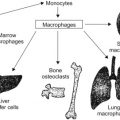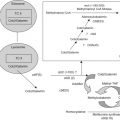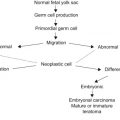Abstract
This chapter focuses on hemolytic anemia caused by extracorpuscular defects due to immune-mediated hemolytic anemia caused by warm and cold antibodies and nonimmune red cell destruction from acquired and mechanical hemolytic anemias.
Keywords
Hemolytic anemia, extravascular hemolysis, intravascular hemolysis, hemoglobinuria, direct antiglobulin test (DAT), Coombs test, warm antibodies, cold antibodies
The causes of hemolytic anemia due to extracorpuscular defects are listed in Table 10.1 ; they may be immune or nonimmune.
|
Immune Hemolytic Anemia
Immune hemolytic anemia can be either isoimmune or autoimmune. Isoimmune hemolytic anemia results from a mismatched blood transfusion or from hemolytic disease of the newborn. In autoimmune hemolytic anemia (AIHA), shortened red cell survival is caused by the action of immunoglobulins with or without the participation of complement on the red cell membrane. The red cell autoantibodies may be of the warm type, the cold type, mixed, with both types present, or the cold Donath–Landsteiner type. The presence of antibody or complement on the red cell surface is measured by the direct antiglobulin test (DAT; previously known as the Coombs test).
Complement participation is usually confined to the immunoglobulin M (IgM) type of antibody; only rarely is it associated with IgG (see Paroxysmal Cold Hemoglobinuria, below). AIHA may be idiopathic or secondary to a number of conditions listed in Table 10.1 .
Warm AIHA
Antibodies of the IgG class are most commonly responsible for AIHA in children. The antigen to which the IgG antibody is directed is one of the Rh erythrocyte antigens in more than 70% of cases. This antibody usually has its maximal activity at 37°C and the resultant hemolysis is called warm antibody-induced hemolytic anemia.
Rarely, warm reacting IgA and IgM antibodies may be responsible for hemolytic anemia. As in all patients with AIHA, erythrocyte survival is generally proportional to the amount of antibody on the erythrocyte surface, although rarely hemolysis can occur in patients with too few antibodies on the surface of the red cell to cause a positive DAT (DAT-negative hemolytic anemia).
Clinical Features
- •
Severe, life-threatening condition.
- •
Sudden onset of pallor, jaundice, dark urine.
- •
Splenomegaly.
Laboratory Findings
- •
Hemoglobin level: very low in fulminant disease or normal in indolent disease.
- •
Reticulocytosis: common although often the reticulocytes are destroyed by the antibody as well and reticulocytopenia may occur.
- •
Mean corpuscular hemoglobin concentration may be elevated.
- •
Smear: prominent spherocytes, polychromasia, macrocytes, autoagglutination (IgM), nucleated red blood cells, erythrophagocytosis.
- •
Neutropenia and thrombocytopenia (occasionally).
- •
Increased osmotic fragility and autohemolysis proportional to spherocytes.
- •
DAT positivity establishes the diagnosis of AIHA.
- •
Hyperbilirubinemia and increased serum lactate dehydrogenase.
- •
Haptoglobin level is markedly decreased.
- •
Hemoglobinuria usually only at first presentation, increased urinary urobilinogen.
Management
Because this is potentially a life-threatening condition, the following must be monitored carefully:
- •
Hemoglobin level (every 4 h).
- •
Reticulocyte count (daily).
- •
Splenic size (daily).
- •
Hemoglobinuria (daily).
- •
Haptoglobin level (weekly).
- •
DAT (weekly).
Close attention should always be paid to supportive care issues such as folic acid supplementation, hydration status, urine output, and cardiac status.
Treatment
Blood Transfusion
Transfusion should be avoided, when possible, because there will be no truly compatible blood available and the survival of transfused cells in this situation is quite limited and may fail to elevate the hemoglobin level significantly. Nonetheless, using the “least incompatible” blood may be required in properly selected situations in order to avoid cardiopulmonary compromise. The guidelines listed below should be followed:
- •
If a specific antibody is identified, a compatible donor may be selected. The antibody usually behaves as a panagglutinin and no totally compatible blood can be found.
- •
Washed packed red cells should be used from donors whose erythrocytes show the least agglutination in the patient’s serum.
- •
The volume of transfused blood should only be of sufficient quantity to relieve any cardiopulmonary embarrassment from the anemia. Aliquots of 5 ml/kg are taken from a single unit and transfused at a rate of 2 ml/kg/h.
- •
The use of such incompletely matched blood is made relatively safe by biologic cross-matching, transfusing of relatively small volumes of blood at any given time and concomitant use of high-dose corticosteroid therapy.
Corticosteroid Therapy
- •
Prednisone 2–10 mg/kg/day orally or methylprednisone 4–8 mg/kg/day IV (both given over four doses each day) for 3 days followed by oral prednisone.
- •
High-dose corticosteroid therapy should be maintained for several days. Thereafter, corticosteroid therapy in the form of prednisone should be slowly tapered over a 3- to 4-week period.
The dose of prednisone should be tailored to maintain the hemoglobin at a reasonable level; when the hemoglobin stabilizes, the corticosteroids should be discontinued. The presence of a continued positive DAT does not preclude continuing to taper steroids as long as the hemoglobin is stable or rising and reticulocytosis continues to decrease or remain normal.
About 50% of patients respond within 4–7 days to corticosteroid therapy, but there are a number of patients who continue with profound hemolysis for the first week after initiation of therapy. For these patients and patients who appear dependent on steroids alternative treatment needs to be considered.
Intravenous Gammaglobulin
Doses in the range of 1–5 g/kg have been employed but response in children is poor. It should be considered in patients with severe hemolysis who are requiring transfusion and are having poor responses to transfusion.
Rituximab
In patients with severe disease not responding early on or in patients exhibiting steroid dependence, rituximab (a manufactured antibody targeting CD20) should be used in doses of 375 mg/m 2 once a week for 4 weeks. It has a very high rate of remission induction in AIHA in children. The short-term side effects include:
- •
Itching.
- •
Hives.
- •
Hypotension.
- •
Chest pain.
These can be prevented through premedication with acetaminophen 15 mg/kg, diphenhydramine 1 mg/kg and, if necessary, corticosteroids. Patients should be monitored carefully during each infusion. Although rituximab eliminates the B-cell compartment, there have not been increased rates of infection, and intravenous gammaglobulin has been administered to offset the loss of B-cell function.
Plasmapheresis
Plasmapheresis has been successful in slowing the rate of hemolysis in patients with severe IgG-induced immune hemolytic anemia. The effect is short-lived if antibody production is ongoing and success is limited. The limited efficacy of plasmapheresis is likely because:
- •
More than half of the IgG is extravascular.
- •
Most of the antibody is on the red cell surface with little remaining free in the plasma.
In IgG warm immune hemolytic anemia, plasmapheresis should always be combined with moderate immunosuppression (e.g., rituximab). This insures that both antibody production and antibody titer reduction are employed concomitantly.
Immunomodulating Agents
- 1.
Mycophenolate mofetil (MMF) . This drug is showing promise in the treatment of a number of autoimmune diseases, including AIHA. It is also effective in Evans syndrome. MMF, as well as the antimetabolites listed below, often require 4–12 weeks for their effects to begin and are usually started as steroids are being weaned. Tacrolimus and sirolimus have also been used in these settings although there are only a few case reports available.
- 2.
Cyclosporine . This drug has been frequently used in immune cytopenias, and in Evans syndrome for patients who are poorly responsive to steroids. Rituximab and MMF are preferred to cyclosporine due to the side-effect profile.
- 3.
Danazol . There has been some success with Danazol (synthetic androgen). Danazol’s early effect appears to be due to decreased expression of macrophage Fc-receptor activity. Its use is less desirable as it has a virilizing effect.
Antimetabolites
Azathioprine and 6-mercaptopurine : As with the immunomodulators they may take 4–12 weeks to provide a steroid-sparing effect.
Alkylating Agents
Cyclophosphamide : This drug is used in patients with severe disease that is unresponsive to steroids, rituximab, or immunomodulators. It is rarely used.
Mitotic Inhibitors
Vincristine and vinblastine: These drugs are rarely used, but when given, are used as a bridge to suppress hemolysis while waiting for an immunomodulator or cytotoxic agent to take effect.
Splenectomy
Splenectomy is indicated if the hemolytic process is brisk despite the use of high-dose corticosteroid therapy, rituximab, and transfusions and the patient cannot maintain a reasonable hemoglobin level safely, or if chronic hemolysis develops.
Splenectomy is beneficial in 60–75% of patients. Whenever possible, children should be older than 5 years of age and the disease should be present for at least 6–12 months with no significant response to medical treatment prior to undertaking splenectomy. Presplenectomy immunization should be instituted.
Giant Cell Hepatitis and DAT-Positive AIHA
This is a specific rare entity of unknown etiology, although an autoimmune component has been suggested because of the association of DAT-positive AIHA and response to immunosuppression.
Clinical Findings
- •
Age: 6–24 months, occasionally older age.
- •
Fever.
- •
Pallor.
- •
Jaundice (progressing to cirrhosis and liver failure).
- •
Firm hepatomegaly and splenomegaly.
- •
Associated convulsions.
Prognosis
Poor.
Laboratory Findings
- •
DAT: mixed (IgG and complement); no evidence of other autoimmunity.
- •
Hemolytic anemia.
- •
Liver function abnormality: high direct bilirubin, transaminase, and serum globulin values; prolonged prothrombin time.
- •
Liver histology: marked lobular fibrosis, extensive necrosis with central-portal bridging and giant cell transformation.
Treatment
Corticosteroids in combination with immunosuppressive agents are the primary therapy as steroids alone cannot typically control the hemolysis. Cytoxan, rituximab, cyclosporine, splenectomy, and azathioprine have all been used. Survival has been achieved with more intensive immunosuppression.
Cold AIHA
IgM antibody-associated hemolysis occurs less often in children than in adults. Most IgM autoantibodies causing immune hemolytic anemia are cold agglutinins, and cold hemagglutinin disease is almost always caused by an IgM antibody. The destruction of red blood cells is triggered by cold exposure.
Cold hemagglutinin disease typically occurs during Mycoplasma pneumoniae infection, although it may also occur with infectious mononucleosis, cytomegalovirus, mumps, and rarely other infections. Cold hemagglutinin disease or IgM-induced hemolysis is usually due to the production of antibodies targeting the I/i system (red cell surface antigens). Anti-I is characteristic of M. pneumoniae -associated hemolysis, and anti-I cold agglutinins are found in infectious mononucleosis. Mycoplasma pneumoniae adherence to the red cell membrane appears to be mediated by sialic-acid-containing receptors, associated with terminal galactose residues of the I antigen. The association of the infecting organism with the red blood cell may alter the antigenic structure of red blood cell membrane antigen, rendering it immunogenic. In children, the IgM antibody is usually polyclonal and immunologically heterogeneous.
Clinical Features
This disease may be idiopathic but is more frequently seen in conjunction with infections such as M. pneumoniae (atypical pneumonia) and less commonly with lymphoproliferative disorders. The features are:
- •
Hemoglobin is usually normal or mildly decreased and the reticulocyte count may be elevated.
- •
The blood smear may show agglutination and polychromatophilia.
- •
Spherocytosis is usually absent.
- •
The DAT is positive for complement (polyspecific and anti C3-agents) only and is negative for anti-IgG.
- •
Most blood banks do cold agglutinin testing only when the DAT is positive for complement.
Treatment
- 1.
Control of the underlying disorder.
- 2.
Transfusions may be necessary for patients with significant hemolysis who may be symptomatic. Identification of compatible blood may prove difficult and the blood bank may have to release a “least incompatible” unit of blood. Warming the blood to 37°C during administration by means of a heating coil or water bath is indicated to avoid further temperature activation of the antibody. Efficient in-line blood warmers (McGaw Water Bath; Fenwall Dry Heat Warmer) are designed to deliver blood at 37°C to the patient. Unmonitored or uncontrolled heating of blood is extremely dangerous and should not be attempted. Red cells heated too long are rapidly destroyed in vivo and can be lethal to the patient.
- 3.
Warm the patient’s room. Keeping a patient warm will help diminish hemolysis and peripheral agglutination.
- 4.
Plasmapheresis is very efficient for the treatment of IgM disease as IgM is largely intravascular. Patients with severe hemolysis should undergo plasmapheresis.
- 5.
Autotransfusion of red blood cells can be performed if the blood is obtained at 37°C, with the patient’s arm warmed by hot pads. The warm unit can be separated quickly by centrifugation and the red cells returned to the patient through an efficient in-line blood warmer.
- 6.
Drug therapy. If the anemia is severe, a drug trial is appropriate. Rituximab and cyclophosphamide have been used with plasmapheresis. Steroids are of marginal value in cold agglutinin disease.
Paroxysmal Cold Hemoglobinuria Due to Donath–Landsteiner Cold Hemolysin
This is an unusual IgG antibody with anti-P specificity and a cold thermal amplitude, originally described in cases of syphilis. This antibody, although uncommon, is most frequently found in young children with viral infections. Hemolysis is most commonly intravascular as a result of the unusual complement-activating efficiency of this IgG antibody.
Clinical Features
The most common clinical finding is a sudden bout of hemolysis with a drop in hemoglobin and hemoglobinuria. The hemoglobin drop is often serious enough to require transfusion (and sudden death from this disease has been reported). Children usually have a short-lived, explosive illness where the antibody is only produced for a short time. Although blood for transfusion will appear compatible, all red cells carry the P blood group specificity against which the antibody is directed.
Laboratory Findings
A positive complement test is present on antiglobulin testing and this should lead to testing for the Donath–Landsteiner antibody (the IgG cold binding antibody) in the absence of an obvious IgM cold agglutinin.
Treatment
Keeping a patient warm is the mainstay of treatment and warming blood in a blood warmer prior to transfusion is important. Patients with ongoing severe hemolysis may benefit from plasmapheresis despite the fact that the disease is caused by an IgG antibody. Steroid use should be reserved for refractory patients. Rituximab may be effective.
Stay updated, free articles. Join our Telegram channel

Full access? Get Clinical Tree






